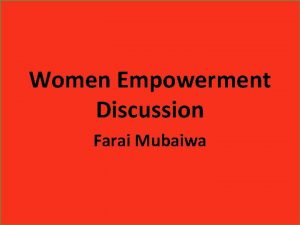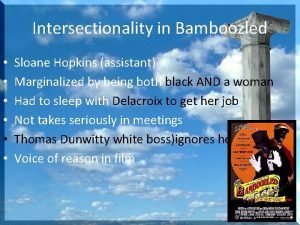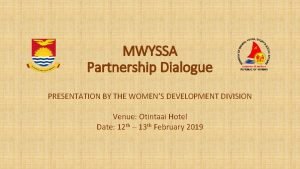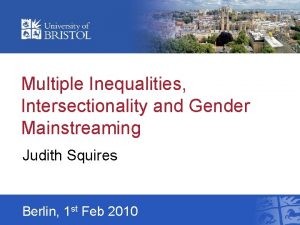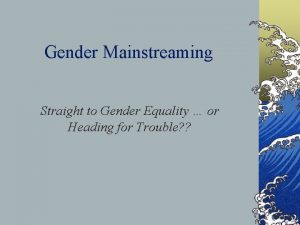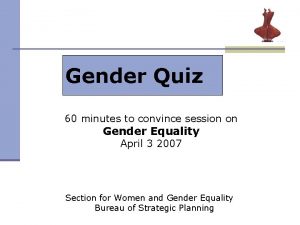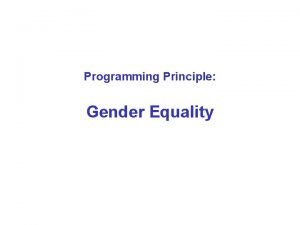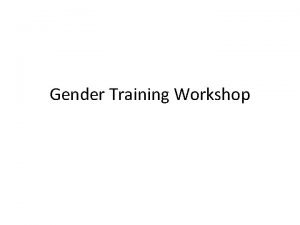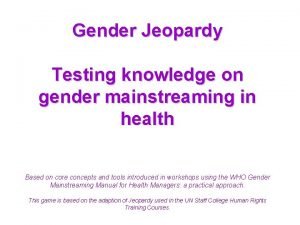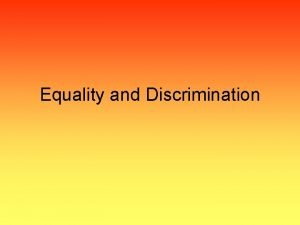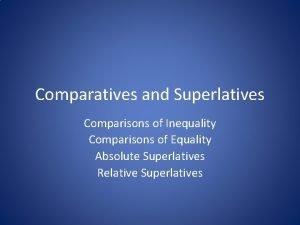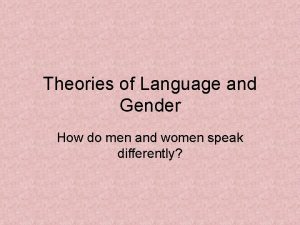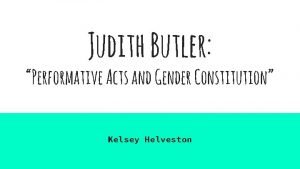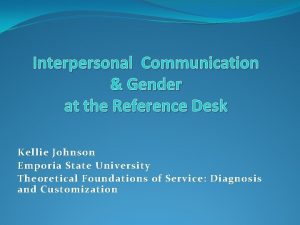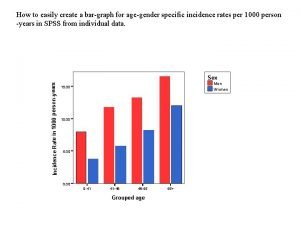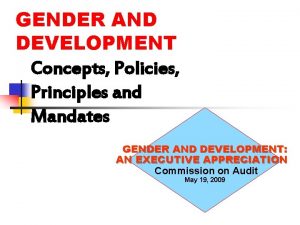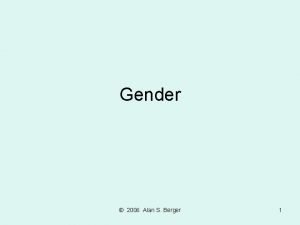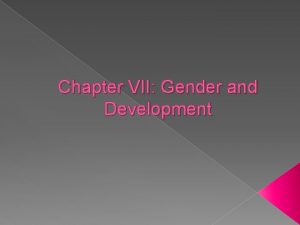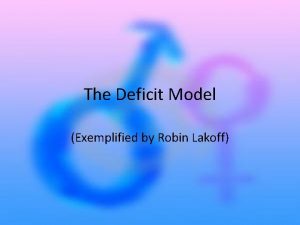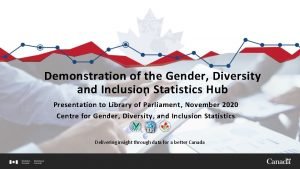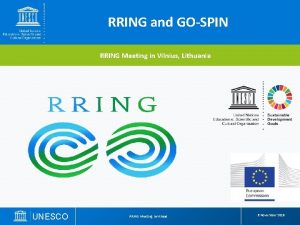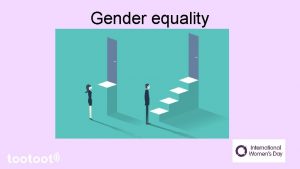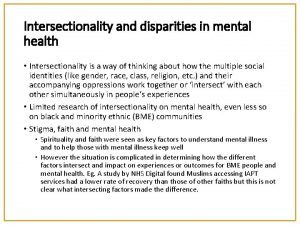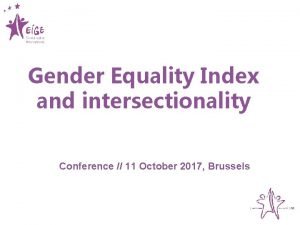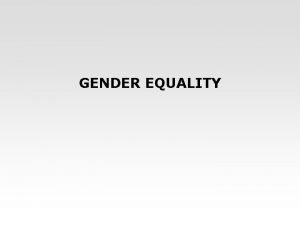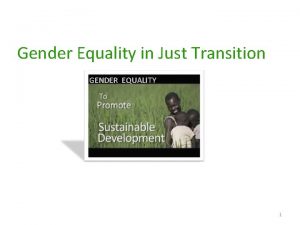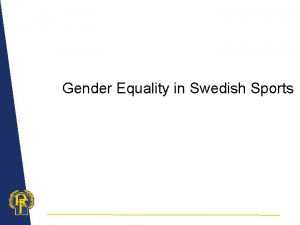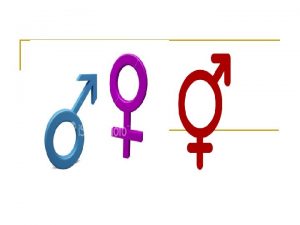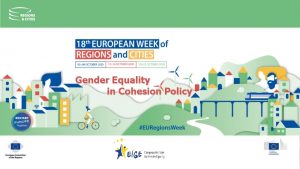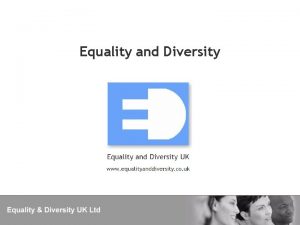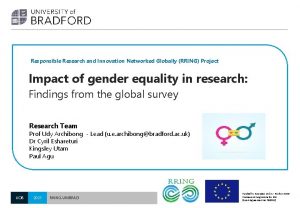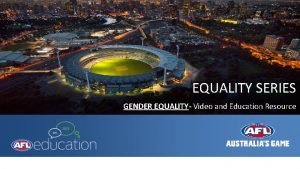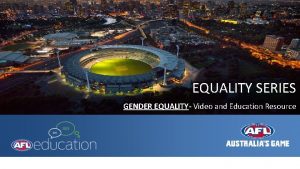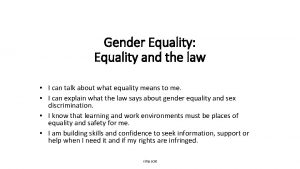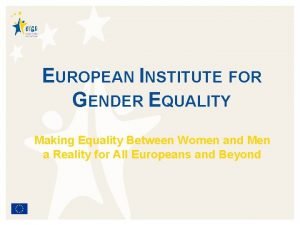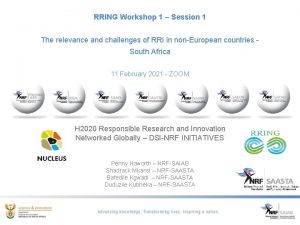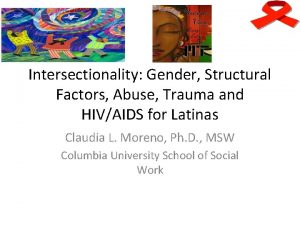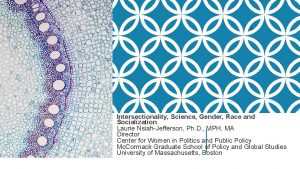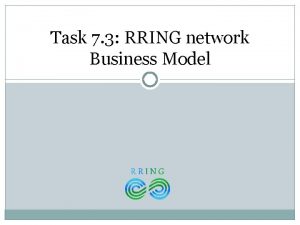RRING project Gender Equality and Intersectionality WP 3





























- Slides: 29

RRING project: Gender Equality and Intersectionality

WP 3: Addressing gender equality

T 3. 2 ● Gender equality included as one of the RRI keys

T 3. 3 ● ● Gender equality included in data collection approach (qualitative interviews) Embedded in interview protocols

T 3. 3 interview protocols Accounting for interview-participant power dynamics (1/2) ● Power is a central aspect to consider by a successful interviewer-participant relationship ● The balances of power may change when the interviewer partners with research participants as part of the community rather than entering as experts ● The power dynamics become more important when there are cultural and gender differences between the parties requiring a culturally sensitive approach

T 3. 3 interview protocols Accounting for interview-participant power dynamics (2/2) ● There are several ways of establishing a culturally sensitive approach within the interview – The interviewer should establish a good rapport with the participant to break the ice, before embarking on the interview proper, thereby encouraging the participant to trust and share accurate information on the topic to be discussed – Without rapport, even the best-phrased questions can fall flat and elicit brief, uninformative answers ● Rapport means more than just putting people at ease – It means convincing people that you are listening, that you understand are interested in what they are talking about, and that they should continue talking. (p. 4)

Gender of interview participants (T 3. 3 interview protocols) ● Aim for 50% male, 50% female or other gender identities gender split between your participants – If you cannot meet this target, then a minimum of 40% female or other gender identities representation is acceptable ● Regardless of difficulties, you must do everything you can to ensure there is at least one male and one female respondent in your sample. (p. 5)

Advice for during the interview, whilst asking the interview questions (1/2) ● Where you have the option of choosing between multiple interviewers from your particular partner/sub-contractor to do the interview, it is important to remember the role of gender dynamics. ● Therefore, if possible, female participants should be interviewed by a female interviewers – If that is not possible, then the male interviewer should be aware of gender power dynamics and wherever possible should create a space where the interview participant feels comfortable.

Advice for during the interview, whilst asking the interview questions (2/2) ● Specifically, the interviewer should be sure to use gender sensitive language – e. g. in discussions, do not say “he” or “she” when the gender role is unknown use “they” ● and give equal value to both women’s and men’s experiences – e. g. when probing more deeply into professional experiences of colleagues and others in the interview participant’s networks (p. 10 -11)

Gender balance for T 3. 3 interviews Breakdown of male/female interview participants: 1. 138 participants (a few 2 - or 3 -person interviews means that this is higher than the interview number) a. 75 male (54. 3%) b. 63 female (45. 7%)

Applying Intersectionality ● Intersectionality contributes to better outcomes for seeking equality as people are considered as a whole, not just with one part of their identity


Defining Intersectionality ● Intersectionality is a contextual framework for examining how systems of oppression deeply intertwine and influence experiences and opportunities ● As shown on the previous slide, the systems that shape experiences cannot be separated (even though they are often studied separately)

Defining Intersectionality ● For example, a black woman with a disability does not experience her engineering workplace only as a woman, black person, or person with a disability, but instead through her own unique interaction with the systems in which she is situated ● Intersectional analysis deepens understanding of and ability to improve intertwined working and personal lives of marginalized groups in research and innovation

Guiding Inclusive Survey Design ● Surveys may offer a limited set of categories for gender, race and ethnicity, and few ask questions about sexuality or disability ● An intersectional approach pushes researchers to expand the options offered to participants in questionnaires to better represent identities and experiences – For instance, instead of listing only two, mutually exclusive gender options (man and woman), researchers can also offer categories such as non-binary for more inclusive survey results

Gaining New Insights on Existing Data ● Often, research and innovation equity and participation research looks at demographic categories like gender and race separately and even in ways that reinforce stereotypes – For example, retention research often attributes women’s departure from STEM jobs to family-related reasons ● AWIS intersectionality research presents research influenced by gender and race, demonstrating that STEM attrition connects to systemic issues related to hiring, promotion, and working conditions

Thinking Critically ● Whether in research, advocacy or practice, an intersectional approach helps focus on systems and contexts ● This includes: ● reviewing research questions asked ● questioning assumptions made in policies and programs considering who the work impacts (or doesn’t) ● noticing whose voices are missing ● connecting what is discovered to larger systemic issues.


Implications for RRING? ● Given we are a global RIA project, we have a wide range of variables and perspectives to account for ● Limitations of univariate analysis ● Are our analyses as diverse as the international research and innovation contexts that we are addressing? ● Are we taking a sufficiently systemic perspective? ● Are we categorising people based only on one variable rather than accounting for intersectionality?

WP 4: Addressing gender equality and related factors

WP 4 subtasks specifically focused on ensuring gender balance ● T 4. 3. 4 Thematic focus analysis on the role of gender (RRI key) and diversity/inclusion (AIRR) across the 4 key domains, 5 UNESCO regions and different stakeholder types ● T 4. 3. 11 Synthesis report drawing together the learning about good RRI-related practices from the comprehensive analysis and thematic focus analyses ● T 4. 4. 6 Thematic focus analysis on the role of gender (RRI key), diversity and inclusion (AIRR dimension) ● T 4. 5. 3 Thematic focus analysis on the role of gender, diversity, social inclusion, ethics, open access/data, public engagement and the SDGs

T 4. 3. 4 Thematic focus analysis on the role of gender (RRI key) and diversity/inclusion (AIRR) across the 4 key domains, 5 UNESCO regions and different stakeholder types (1/2) (UNIBRAD* [2 p-m]; detailed review by DMU [0. 25 p-m] and UPM [0. 25 p-m]; detailed methodological reviews by Fraun [0. 25 p-m]) ● Drawing together all the relevant data from WP 3 and WP 5, this subtask will develop a robust analysis plan – To be reviewed and approved upstream by task and subtask leaders, as well as the subtask reviewers ● and implement it to create a section of the report focusing on theme of gender and diversity/inclusion – Influenced by both AIRR and RRI key definitions of this scope ● The scope includes identifying key RRI players, leaders and networks globally, which are relevant to this theme – It will also include policy drivers and focus areas, terminology, and both the short and medium term horizon

T 4. 3. 4 Thematic focus analysis on the role of gender (RRI key) and diversity/inclusion (AIRR) across the 4 key domains, 5 UNESCO regions and different stakeholder types (2/2) ● This comparative analysis includes: – In-depth comparative analysis across the 4 Key Domains focusing specifically on this theme – A theme-specific comparative analysis (high level) across the geographies, for all RPOs and RFOs – A theme-specific consideration of what the RRING research data show about the “linked up global” extent for RRI policy and practice, role of nation states and international organizations in this global world of RRI in the context of gender, diversity and inclusion ● Results should be prepared in coordination with the task and subtask leaders, and ensure that the quality of the outputs is ‘report ready’ to go into the deliverable – For this reason, outputs should be prepared well in advance of the deadlines to allow sufficient time for multiple iterations of feedback and revision

T 4. 3. 11 Synthesis report drawing together the learning about good RRI-related practices from the comprehensive analysis and thematic focus analyses (EUR* [1 p-m]; Detailed review by DMU [0. 25 p-m], VU [0. 25 pm], focusing especially on gender and ethics aspects) ● Using the inputs from the analyses and syntheses conducted for 4. 3. 3 and 4. 3. 4, a report will be drafted with full methodological details, presenting empirical findings showing ‘good’ RRI-related practices by key domain and by UNESCO geography, as well as different stakeholder types ● The report will include identification of key RRI players, leaders and networks and platforms in RRI globally – This report offers a comparative analysis (high level) across the geographies, for all RPOs (academic and industry) and RFOs

T 4. 4. 6 Thematic focus analysis on the role of gender (RRI key), diversity and inclusion (AIRR dimension) (1/2) (DMU* [1. 25 p-m] completing the work; detailed review by Uni. BRAD [0. 25 pm] and UPM [0. 25 p-m]; detailed methodological review by Fraun [0. 25 p-m]) ● Drawing together the relevant data from the Glocal Workshops, this subtask will develop a robust analysis plan – To be reviewed and approved upstream by task and subtask leaders, as well as reviewers ● and implement it to create a section of the WP 4 deliverable 1 and 2 reports focusing on the role of gender (RRI key), diversity and inclusion (AIRR) from a wider perspective in line with the aims of WP 4 set out in T 4. 4. 1 ● The scope also includes identifying key RRI players, leaders and networks globally, which are relevant to this theme and data – It will also include policy drivers and focus areas, terminology, and both the short and medium term horizon

T 4. 4. 6 Thematic focus analysis on the role of gender (RRI key), diversity and inclusion (AIRR dimension) (2/2) ● ● This comparative analysis includes the following dimensions: – In-depth Comparative analysis across the 4 Key Domains focusing specifically on theme – A comparative analysis (high level) across the geographies, for all participating RPOs and RFOs in terms of how they handle RRI in their ‘glocal’ research and innovation contexts, why and with what key issues raised – A theme-specific consideration of what the RRING WP 4 research data show about the “linked up global” extent for RRI policy and practice, role of nation states and international organisations in this global world of RRI in the context of theme Results should be prepared in coordination with the task and subtask leaders, and ensure that the quality of the outputs is ‘report ready’ to go into the deliverables (this work feeds into the Glocal Workshop sections of the deliverables) – For this reason, outputs should be prepared well in advance of the deadlines to allow sufficient time for multiple iterations of feedback and revision

T 4. 5. 3 Thematic focus analysis on the role of gender, diversity, social inclusion, ethics, open access/data, public engagement and the SDGs (Meiji [1 p-m]; Fraun [0. 25 p-m]; NRF [1 p-m]; Uni. BRAD [1 p-m]; DMU [0. 5 p-m]; VU [0. 25 p-m]; UPM [0. 25 p-m]; UNESCO [0. 25 p-m]) ● How can the gender, diversity and social inclusion aspects of RRI be integrated into the SDGs framework? What is gained or lost by doing so? ● In order to capture the specific comments of the various RRI/AIRR components/issues, the output of T 4. 5. 2 will be submitted to the three parallel reviews conducted in light of state of the art concepts and methods and best practice in the relevant areas – Gender, diversity and social inclusion; Ethics and open access/data; Public engagement ● Separating these reviews will ensure independence of dimensions and help clarify the key challenges in connecting the SDGs to RRI ● In addition, the reviews will serve to identify key players, leaders and networks globally for the integration of RRI and SDGs, which are relevant to this theme and data

References AWIS' Intersectionality Fact Sheet. (2019, October 29). Retrieved from https: //www. awis. org/intersectionality/.

THANK YOU
 Intersectionality image
Intersectionality image Intersectionality
Intersectionality Strategic gender needs and practical gender needs
Strategic gender needs and practical gender needs Mwyssa
Mwyssa Rhetorical questions about gender equality
Rhetorical questions about gender equality Gender equality definition
Gender equality definition What is gender equality answer
What is gender equality answer Methodology of gender inequality
Methodology of gender inequality D s kothari commission
D s kothari commission Short poem on gender inequality
Short poem on gender inequality Example of gender equality
Example of gender equality Gender equality slogan
Gender equality slogan Claudia padovani unipd
Claudia padovani unipd Substantive equality vs formal equality
Substantive equality vs formal equality Cedaw article
Cedaw article Absolute comparative superlative
Absolute comparative superlative Language and gender
Language and gender Snow white gender roles
Snow white gender roles Gender-neutral housing pros and cons
Gender-neutral housing pros and cons Judith butler performative acts
Judith butler performative acts Gender and interpersonal communication
Gender and interpersonal communication Age and gender bar graph
Age and gender bar graph Gender role development
Gender role development Gad goals
Gad goals Social stratification of gender
Social stratification of gender Objectives of gender and development
Objectives of gender and development Deficit model lakoff
Deficit model lakoff Evaluation schema
Evaluation schema Dynamic approach language and gender
Dynamic approach language and gender Centre for gender diversity and inclusion statistics
Centre for gender diversity and inclusion statistics
